标准下载网
www.bzxzw.com
国家标准 书籍手册 质量体系
机械标准 化工标准 工程建设
ASTM 标准 ASME 标准 JIS 标准
ISO 标准 DIN 标准 标准论坛
�
INTERNATIONAL
STANDARD
ISO
31000
First edition
2009-11-15
Risk management — Principles and
guidelines
Management du risque — Principes et lignes directrices
Reference number
ISO 31000:2009(E)
© ISO 2009
�
ISO 31000:2009(E)
PDF disclaimer
This PDF file may contain embedded typefaces. In accordance with Adobe's licensing policy, this file may be printed or viewed but
shall not be edited unless the typefaces which are embedded are licensed to and installed on the computer performing the editing. In
downloading this file, parties accept therein the responsibility of not infringing Adobe's licensing policy. The ISO Central Secretariat
accepts no liability in this area.
Adobe is a trademark of Adobe Systems Incorporated.
Details of the software products used to create this PDF file can be found in the General Info relative to the file; the PDF-creation
parameters were optimized for printing. Every care has been taken to ensure that the file is suitable for use by ISO member bodies. In
the unlikely event that a problem relating to it is found, please inform the Central Secretariat at the address given below.
COPYRIGHT PROTECTED DOCUMENT
© ISO 2009
All rights reserved. Unless otherwise specified, no part of this publication may be reproduced or utilized in any form or by any means,
electronic or mechanical, including photocopying and microfilm, without permission in writing from either ISO at the address below or
ISO's member body in the country of the requester.
ISO copyright office
Case postale 56 • CH-1211 Geneva 20
Tel. + 41 22 749 01 11
Fax + 41 22 749 09 47
E-mail copyright@iso.org
Web www.iso.org
Published in Switzerland
ii
© ISO 2009 – All rights reserved
�
ISO 31000:2009(E)
Contents
Page
Foreword ............................................................................................................................................................iv
Introduction.........................................................................................................................................................v
Scope......................................................................................................................................................1
1
2
Terms and definitions ...........................................................................................................................1
Principles................................................................................................................................................7
3
Framework .............................................................................................................................................8
4
4.1
General ...................................................................................................................................................8
4.2
Mandate and commitment ....................................................................................................................9
4.3
Design of framework for managing risk............................................................................................10
4.3.1 Understanding of the organization and its context .........................................................................10
4.3.2 Establishing risk management policy...............................................................................................10
4.3.3 Accountability......................................................................................................................................11
4.3.4
Integration into organizational processes........................................................................................11
4.3.5 Resources ............................................................................................................................................11
4.3.6 Establishing internal communication and reporting mechanisms ................................................12
4.3.7 Establishing external communication and reporting mechanisms ...............................................12
Implementing risk management ........................................................................................................12
4.4
Implementing the framework for managing risk ..............................................................................12
4.4.1
Implementing the risk management process ...................................................................................13
4.4.2
4.5
Monitoring and review of the framework ..........................................................................................13
4.6
Continual improvement of the framework ........................................................................................13
Process.................................................................................................................................................13
5
5.1
General .................................................................................................................................................13
5.2
Communication and consultation .....................................................................................................14
5.3
Establishing the context.....................................................................................................................15
5.3.1 General .................................................................................................................................................15
5.3.2 Establishing the external context ......................................................................................................15
5.3.3 Establishing the internal context.......................................................................................................15
5.3.4 Establishing the context of the risk management process ............................................................16
5.3.5 Defining risk criteria............................................................................................................................17
5.4
Risk assessment .................................................................................................................................17
5.4.1 General .................................................................................................................................................17
5.4.2 Risk identification................................................................................................................................17
5.4.3 Risk analysis........................................................................................................................................18
5.4.4 Risk evaluation ....................................................................................................................................18
5.5
Risk treatment......................................................................................................................................18
5.5.1 General .................................................................................................................................................18
5.5.2 Selection of risk treatment options ...................................................................................................19
5.5.3 Preparing and implementing risk treatment plans ..........................................................................20
5.6
Monitoring and review ........................................................................................................................20
5.7
Recording the risk management process.........................................................................................21
Annex A (informative) Attributes of enhanced risk management................................................................22
Bibliography......................................................................................................................................................24
© ISO 2009 – All rights reserved
iii
�
ISO 31000:2009(E)
Foreword
ISO (the International Organization for Standardization) is a worldwide federation of national standards bodies
(ISO member bodies). The work of preparing International Standards is normally carried out through ISO
technical committees. Each member body interested in a subject for which a technical committee has been
established has the right to be represented on that committee. International organizations, governmental and
non-governmental, in liaison with ISO, also take part in the work. ISO collaborates closely with the
International Electrotechnical Commission (IEC) on all matters of electrotechnical standardization.
International Standards are drafted in accordance with the rules given in the ISO/IEC Directives, Part 2.
The main task of technical committees is to prepare International Standards. Draft International Standards
adopted by the technical committees are circulated to the member bodies for voting. Publication as an
International Standard requires approval by at least 75 % of the member bodies casting a vote.
Attention is drawn to the possibility that some of the elements of this document may be the subject of patent
rights. ISO shall not be held responsible for identifying any or all such patent rights.
ISO 31000 was prepared by the ISO Technical Management Board Working Group on risk management.
iv
© ISO 2009 – All rights reserved
�
ISO 31000:2009(E)
Introduction
Organizations of all types and sizes face internal and external factors and influences that make it uncertain
whether and when they will achieve their objectives. The effect this uncertainty has on an organization's
objectives is “risk”.
All activities of an organization involve risk. Organizations manage risk by identifying it, analysing it and then
evaluating whether the risk should be modified by risk treatment in order to satisfy their risk criteria.
Throughout this process, they communicate and consult with stakeholders and monitor and review the risk
and the controls that are modifying the risk in order to ensure that no further risk treatment is required. This
International Standard describes this systematic and logical process in detail.
While all organizations manage risk to some degree, this International Standard establishes a number of
principles that need to be satisfied to make risk management effective. This International Standard
recommends that organizations develop, implement and continuously improve a framework whose purpose is
to integrate the process for managing risk into the organization's overall governance, strategy and planning,
management, reporting processes, policies, values and culture.
Risk management can be applied to an entire organization, at its many areas and levels, at any time, as well
as to specific functions, projects and activities.
Although the practice of risk management has been developed over time and within many sectors in order to
meet diverse needs, the adoption of consistent processes within a comprehensive framework can help to
ensure that risk is managed effectively, efficiently and coherently across an organization. The generic
approach described in this International Standard provides the principles and guidelines for managing any
form of risk in a systematic, transparent and credible manner and within any scope and context.
Each specific sector or application of risk management brings with it individual needs, audiences, perceptions
and criteria. Therefore, a key feature of this International Standard is the inclusion of “establishing the context”
as an activity at the start of this generic risk management process. Establishing the context will capture the
objectives of the organization, the environment in which it pursues those objectives, its stakeholders and the
diversity of risk criteria – all of which will help reveal and assess the nature and complexity of its risks.
The relationship between the principles for managing risk, the framework in which it occurs and the risk
management process described in this International Standard are shown in Figure 1.
When implemented and maintained in accordance with this International Standard, the management of risk
enables an organization to, for example:
increase the likelihood of achieving objectives;
encourage proactive management;
be aware of the need to identify and treat risk throughout the organization;
improve the identification of opportunities and threats;
comply with relevant legal and regulatory requirements and international norms;
improve mandatory and voluntary reporting;
improve governance;
improve stakeholder confidence and trust;
© ISO 2009 – All rights reserved
v
⎯
⎯
⎯
⎯
⎯
⎯
⎯
⎯
�
ISO 31000:2009(E)
establish a reliable basis for decision making and planning;
improve controls;
effectively allocate and use resources for risk treatment;
improve operational effectiveness and efficiency;
enhance health and safety performance, as well as environmental protection;
improve loss prevention and incident management;
minimize losses;
improve organizational learning; and
improve organizational resilience.
This International Standard is intended to meet the needs of a wide range of stakeholders, including:
a)
those responsible for developing risk management policy within their organization;
b)
those accountable for ensuring that risk is effectively managed within the organization as a whole or
within a specific area, project or activity;
c)
those who need to evaluate an organization's effectiveness in managing risk; and
d) developers of standards, guides, procedures and codes of practice that, in whole or in part, set out how
risk is to be managed within the specific context of these documents.
The current management practices and processes of many organizations include components of risk
management, and many organizations have already adopted a formal risk management process for particular
types of risk or circumstances. In such cases, an organization can decide to carry out a critical review of its
existing practices and processes in the light of this International Standard.
In this International Standard, the expressions “risk management” and “managing risk” are both used. In
general terms, “risk management” refers to the architecture (principles, framework and process) for managing
risks effectively, while “managing risk” refers to applying that architecture to particular risks.
vi
© ISO 2009 – All rights reserved
⎯
⎯
⎯
⎯
⎯
⎯
⎯
⎯
⎯
�
ISO 31000:2009(E)
Monitoring and review (5.6)
t
x
e
t
n
o
c
)
3
.
5
(
e
h
t
g
n
h
s
i
i
l
b
a
t
s
E
)
2
.
e
t
a
d
n
a
M
d
n
a
4
(
t
n
e
m
t
i
m
m
o
c
)
2
.
4
.
5
(
n
o
i
t
a
c
i
f
i
t
n
e
d
i
k
s
R
i
.
)
4
5
(
t
n
e
m
s
s
e
s
s
a
.
.
i
)
3
4
5
(
s
s
y
a
n
a
k
s
R
i
l
)
4
.
4
.
5
(
n
o
i
t
a
u
a
v
e
l
k
s
R
i
k
s
R
i
Communication and consultation (5.2)
g
n
i
t
n
e
m
e
p
m
l
I
k
s
i
r
)
4
.
4
(
t
n
e
m
e
g
a
n
a
m
f
o
n
g
s
e
D
k
r
o
w
e
m
a
r
f
i
k
s
i
r
g
n
g
a
n
a
m
i
r
o
f
)
3
.
4
(
g
n
i
r
o
t
i
n
o
M
w
e
i
v
e
r
d
n
a
e
h
t
f
o
k
r
o
w
e
m
a
r
f
)
5
.
4
(
)
5
.
5
(
t
n
e
m
t
a
e
r
t
k
s
R
i
k
r
o
w
e
m
a
r
F
s
s
e
c
o
r
P
)
5
e
s
u
a
C
l
(
)
4
e
s
u
a
C
l
(
l
a
u
n
i
t
n
o
C
t
n
e
m
e
v
o
r
p
m
e
h
t
f
o
k
r
o
w
e
m
a
r
f
)
6
.
4
(
i
d
e
r
o
l
i
a
T
)
g
t
s
e
b
e
h
t
n
o
d
e
s
a
B
)
f
n
o
i
t
a
m
r
o
f
n
i
e
l
b
a
l
i
a
v
a
g
n
i
k
a
m
n
o
i
s
i
c
e
d
f
o
t
r
a
P
)
c
s
e
s
s
e
r
d
d
a
y
l
t
i
c
i
l
p
x
E
)
d
y
t
n
i
a
t
r
e
c
n
u
d
e
r
u
t
c
u
r
t
s
,
c
i
t
a
m
e
t
s
y
S
)
e
y
l
e
m
i
t
d
n
a
e
v
i
s
u
l
c
n
i
d
n
a
t
n
e
r
a
p
s
n
a
r
T
)
i
d
n
a
e
v
i
t
a
r
e
t
i
,
c
i
m
a
n
y
D
e
g
n
a
h
c
o
t
e
v
i
s
n
o
p
s
e
r
)
j
d
n
a
n
a
m
u
h
s
e
k
a
T
)
h
o
t
n
i
s
r
o
t
c
a
f
l
a
r
u
t
l
u
c
t
n
u
o
c
c
a
s
e
s
s
e
c
o
r
p
l
a
n
o
i
t
a
z
i
n
a
g
r
o
f
o
t
r
a
p
l
a
r
g
e
t
n
I
)
b
e
u
l
a
v
s
e
t
a
e
r
C
)
a
l
a
u
n
i
t
n
o
c
s
e
t
a
t
i
l
i
c
a
F
)
k
e
h
t
f
o
t
n
e
m
e
c
n
a
h
n
e
d
n
a
t
n
e
m
e
v
o
r
p
m
i
n
o
i
t
a
z
i
n
a
g
r
o
s
e
l
p
i
c
n
i
r
P
)
3
e
s
u
a
l
C
(
Figure 1 — Relationships between the risk management principles, framework and process
© ISO 2009 – All rights reserved
vii
�

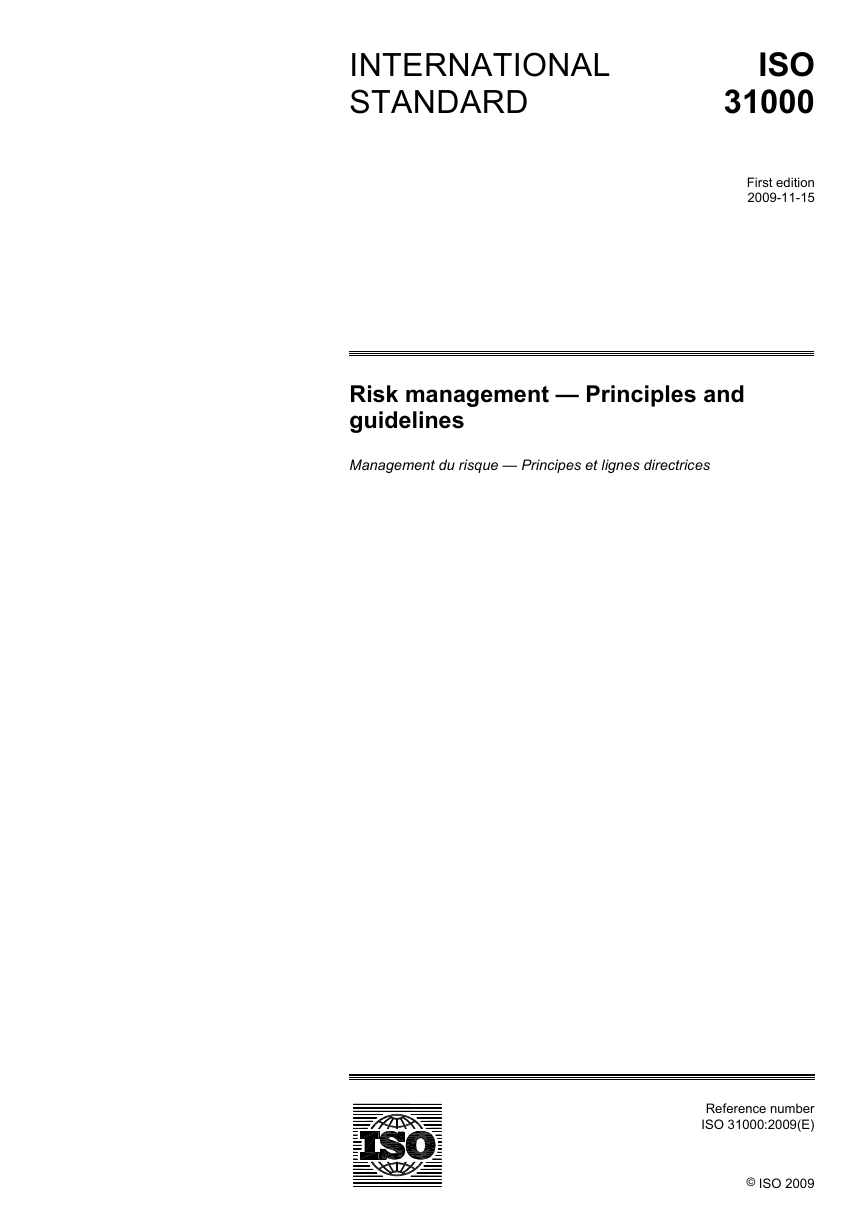
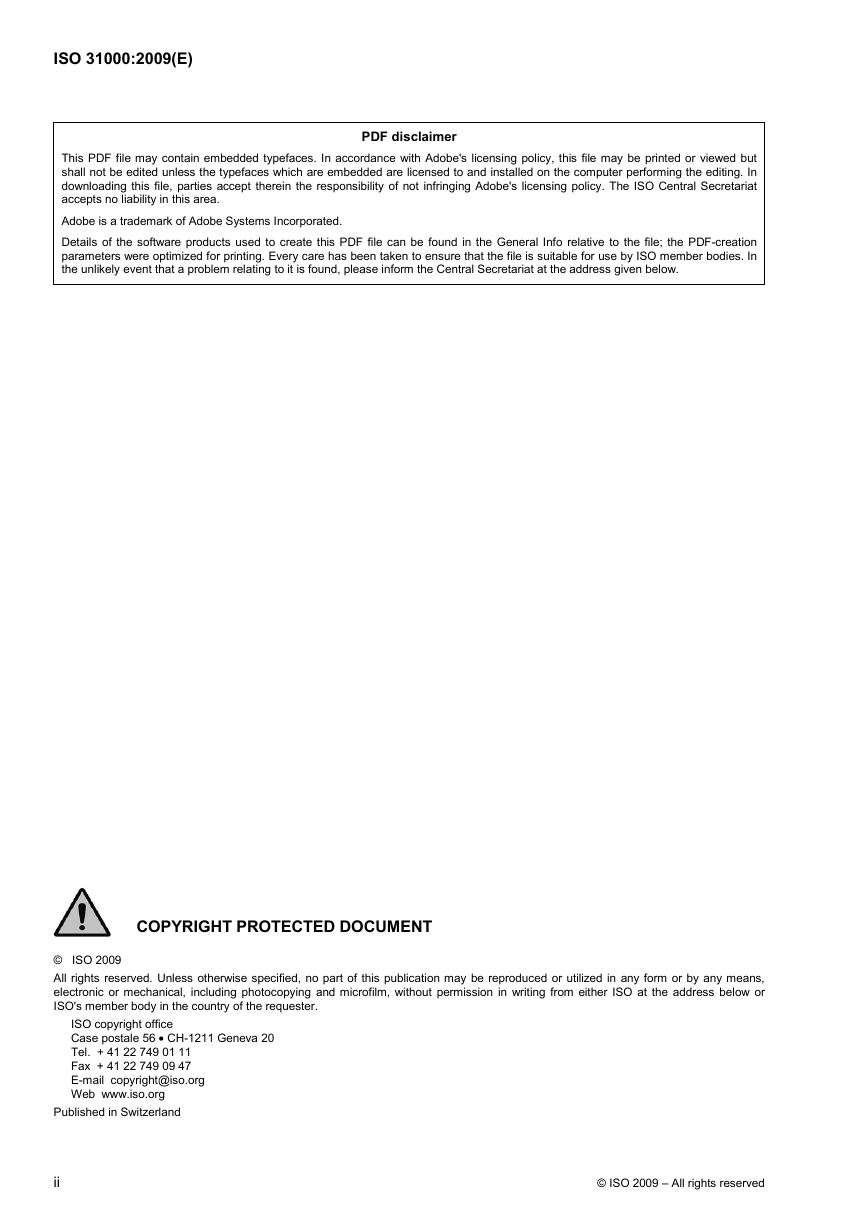

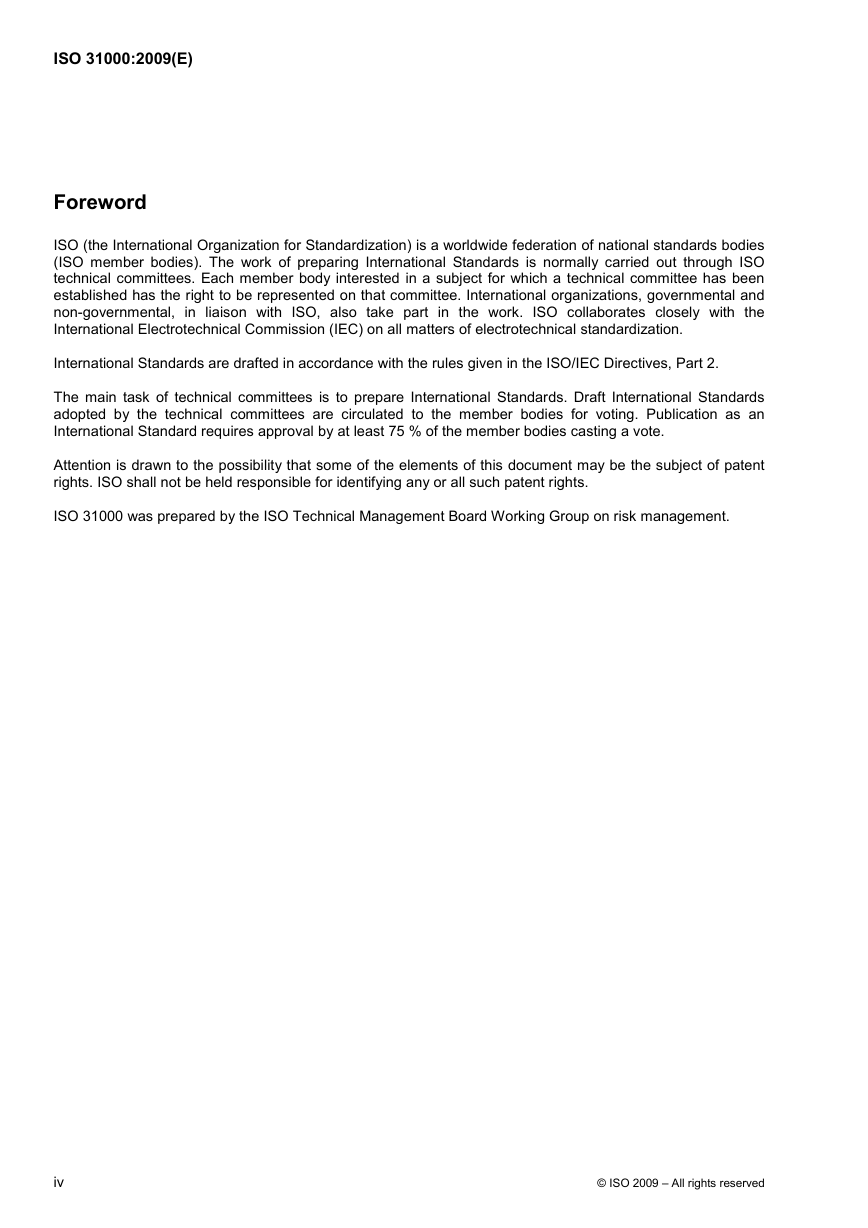
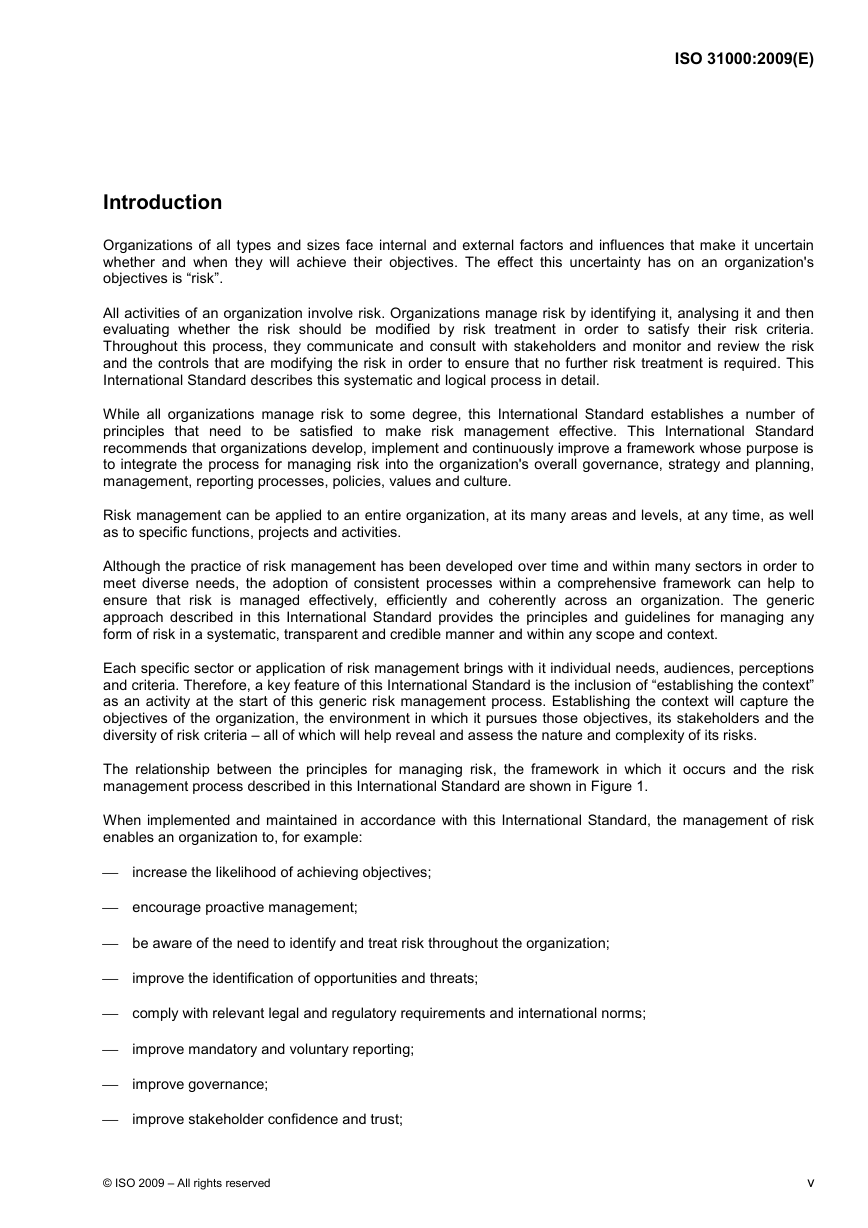
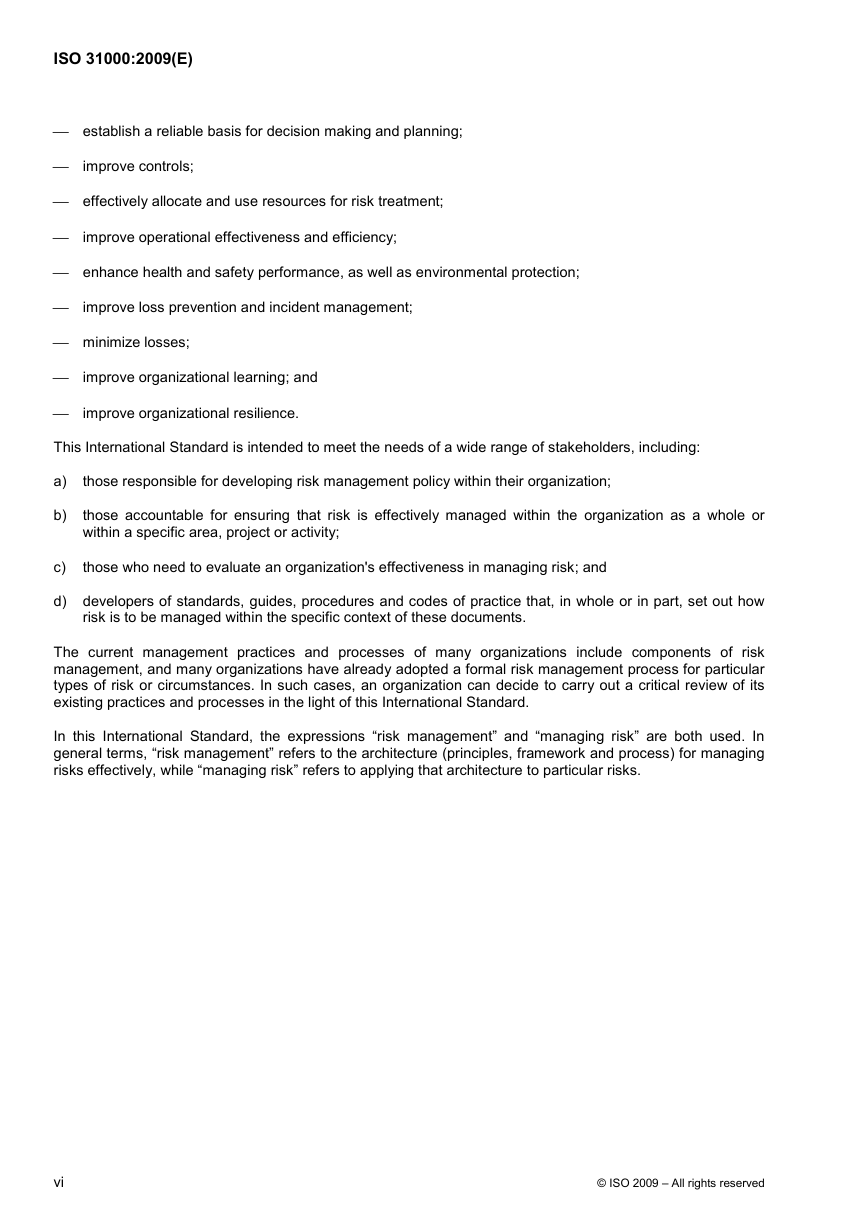
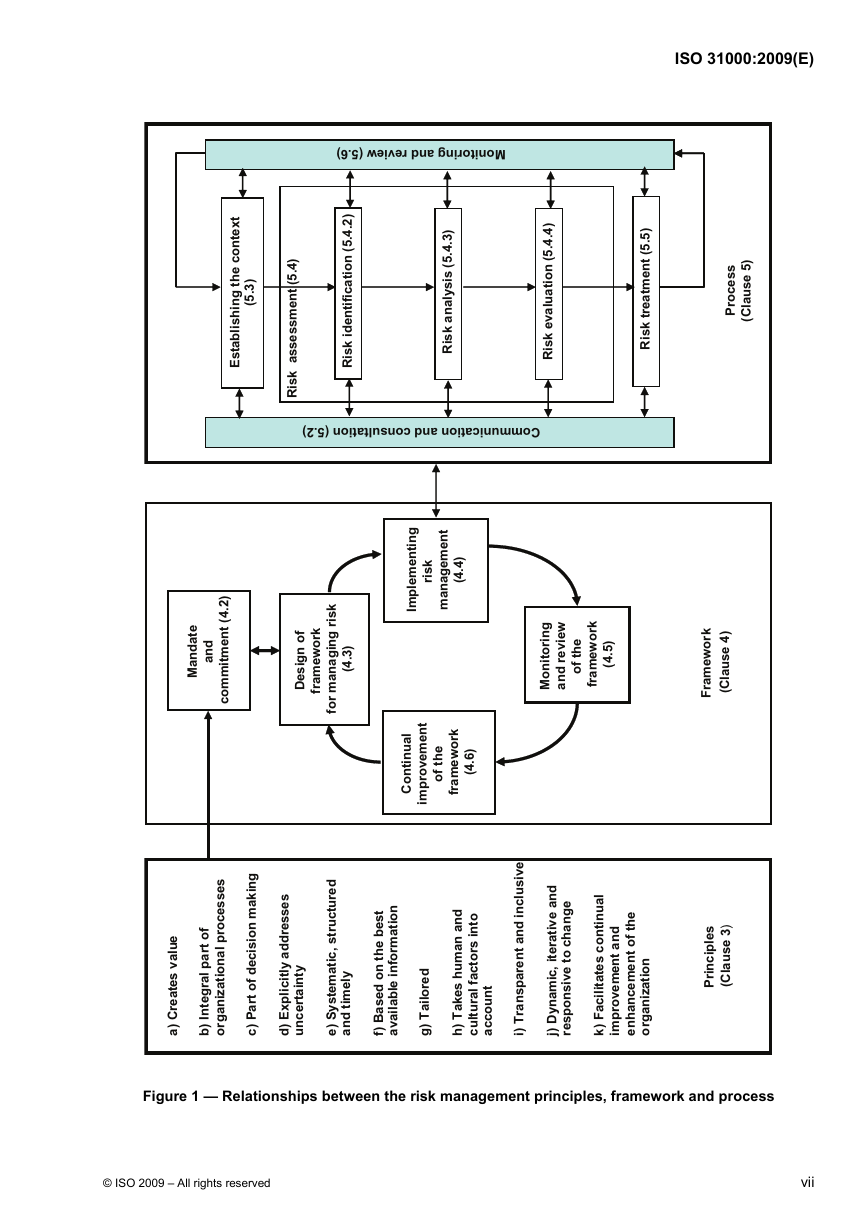








 2023年江西萍乡中考道德与法治真题及答案.doc
2023年江西萍乡中考道德与法治真题及答案.doc 2012年重庆南川中考生物真题及答案.doc
2012年重庆南川中考生物真题及答案.doc 2013年江西师范大学地理学综合及文艺理论基础考研真题.doc
2013年江西师范大学地理学综合及文艺理论基础考研真题.doc 2020年四川甘孜小升初语文真题及答案I卷.doc
2020年四川甘孜小升初语文真题及答案I卷.doc 2020年注册岩土工程师专业基础考试真题及答案.doc
2020年注册岩土工程师专业基础考试真题及答案.doc 2023-2024学年福建省厦门市九年级上学期数学月考试题及答案.doc
2023-2024学年福建省厦门市九年级上学期数学月考试题及答案.doc 2021-2022学年辽宁省沈阳市大东区九年级上学期语文期末试题及答案.doc
2021-2022学年辽宁省沈阳市大东区九年级上学期语文期末试题及答案.doc 2022-2023学年北京东城区初三第一学期物理期末试卷及答案.doc
2022-2023学年北京东城区初三第一学期物理期末试卷及答案.doc 2018上半年江西教师资格初中地理学科知识与教学能力真题及答案.doc
2018上半年江西教师资格初中地理学科知识与教学能力真题及答案.doc 2012年河北国家公务员申论考试真题及答案-省级.doc
2012年河北国家公务员申论考试真题及答案-省级.doc 2020-2021学年江苏省扬州市江都区邵樊片九年级上学期数学第一次质量检测试题及答案.doc
2020-2021学年江苏省扬州市江都区邵樊片九年级上学期数学第一次质量检测试题及答案.doc 2022下半年黑龙江教师资格证中学综合素质真题及答案.doc
2022下半年黑龙江教师资格证中学综合素质真题及答案.doc